Imagine you're on a road trip. You need to pull over at a rest stop a few times to check your map, refuel, and see if you're on the correct route or need to adjust your course.
The same case applies to your social media presence. From time to time, you must assess your goals, optimize profiles, and determine whether you're achieving results or need to restrategize.
Conducting a social media audit will help you determine if your content and brand initiatives are still resonating with your target audience, or if you need to work on some improvements if there are misalignments somewhere.
According to a data report by Sprout Social, 65% of consumers trust a brand with a solid social media presence. That means you must optimize your strategy to reach the right audience with the right content.
Let's learn step-by-step how to run a social media audit. This will help you clearly understand your social media performance and its alignment with your goals.
TL;DR: Quick Steps to Conducting a Social Media Audit
- Set your social media audit goals. For example, your goal could be to drive 15% more traffic from social media to your website in Q2 of 2024.
- Identify and take an inventory of your social media accounts.
- Analyze specific performance metrics of your social media marketing campaigns and use analytics tools to get deeper insights. Some key metrics include post likes, comments, shares, and click-through rates (CTR).
- Evaluate your social media content strategy — compare engagement across all content formats to find the type of content that drives maximum engagement.
- Understand your social media audience demographics, interests, and behaviors to tailor your content to build strong connections.
- Conduct a social media competitive analysis to understand the engagement strategies and content gaps of your competitors.
- Implement changes and monitor progress over the next few weeks to gauge the effectiveness of your new social media strategy.
Why Should You Perform a Social Media Audit for Your Business?
Conducting a social media audit for your business helps you optimize your online presence, reach your target audience effectively, and achieve your marketing goals.
Here are the benefits of doing a social media audit for your business profiles:
- An understanding of what's working: It enables you to analyze your social’s content performance, engagement metrics, content reach, and follower demographics.It also lets you see which content types receive low engagement or inconsistencies in your brand messaging. Through your analysis, you can identify your strengths and weaknesses, helping you pinpoint areas for improvement.
- Better results and ROI: Conducting a social media audit helps you focus your efforts on platforms and content formats that deliver the best results for your specific goals, for example brand awareness, lead generation, or website traffic. You can prioritize social channels with more engagement, ensuring you get the most ROI from your time and budget.
- Identification of new trends and opportunities: To stay relevant and ahead of the curve, you must be informed about emerging social media trends, platforms, content formats, and audience preferences. During an audit, you can compare your social media presence to industry leaders and competitors to identify areas for improvement and get inspiration.
- Improved brand image: A social media audit will help you identify and address negative feedback promptly to maintain a positive brand image. You will learn the type of content that reflects your brand identity, positioning, and thought leadership in your industry.
- Enhanced customer engagement: An audit will help you learn when your audience is most active on each social network. You can leverage that information to strategize the deployment schedules of your content, stay active and respond to comments, and monitor conversations to understand what resonates with your audience.
A Step-by-Step Guide on How to Do a Social Media Audit
Your social media audit ensures you gather the right information, analyze it, and use it for improvement. Let's explore the process of conducting a social media audit.
1. Set Your Social Media Audit Goals
Setting clear, measurable goals is essential for your social media audit. Goals guide your analysis, helping you focus on metrics and insights relevant to your desired results.
Without clear goals, your audit leads to vague recommendations.
Measurable goals allow you to translate findings into specific actions for improvement. You can allocate resources strategically to areas with the greatest potential impact based on your objectives and learn if your efforts are paying off.
Here are examples of reasonable social media audit goals:
- Increase engagement rate by 5% on Instagram within the next three months.
- Boost website conversion rate from social media traffic by 15% in Q2.
- Refine the target audience on X (formerly Twitter) to include Gen Z by May.
Remember to align your social media audit goals with your overall business objectives and leave room for adaptation based on audit findings.
2. Take Inventory of Your Social Media Accounts
You must know all your brand's social media profiles online for effective management and consistent brand messaging.
Maintaining a consistent brand image across all platforms builds trust, recognition, and a stronger online presence. For example, you can use the same profile pictures, bios, messaging tone, and visual elements.
Knowing all your accounts helps you secure them from hacking, identity theft, and reputational damage.
Follow these steps to identify and list all your accounts:
- Check with your marketing, communications, and customer service teams to identify all active and track forgotten accounts.
- Conduct Google searches using your brand name, associated keywords, and variations to see what pops up.
- Create a central spreadsheet to list all identified social media accounts. Include platform name, username, account type, creation date, and activity level (active, inactive, abandoned).
- Use a social media marketing tool like Tailwind or Sprout Social to add and manage all of the social media profiles linked to your brand in one place.
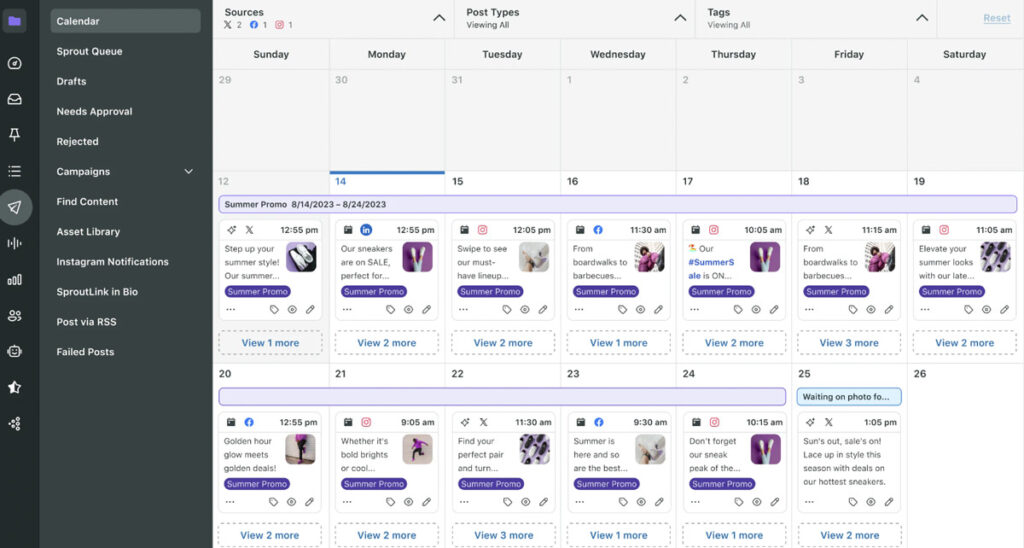
- For each account, update login information, enable two-factor authentication, and configure security settings.
- Identify and remove unnecessary or unclaimed accounts to avoid brand confusion and security risks.
Conducting a social media audit is an ongoing process. Keep re-evaluating your presence and addressing security concerns.
3. Analyze the Key Performance Metrics of Your Social Media Strategy
Every social platform has its unique content format and audience. That means you need a tailored approach for each of your social media platforms to stay competitive and relevant.
First, you need to identify the key performance indicators (KPIs) for each platform and utilize proper data-gathering tools to achieve practical analysis.
Here are the KPIs for different social media platforms:
- Facebook: Page likes, post likes, comments, shares, reach, impressions, click-through rate (CTR), and website traffic from Facebook.
- X (formerly Twitter): Impressions, reposts, replies, engagement rate (reposts + replies), hashtags performance, follower growth, and mentions.
- Instagram: Follower growth, likes, comments, saves, Story views, reach, impressions, hashtag performance, website clicks.
- TikTok: Views, favorites, likes, shares, follower growth, comments.
- YouTube: Views, watch time, subscriber growth, engagement (likes, comments), CTR, audience retention.
- LinkedIn: Post impressions, reactions, comments, shares, CTR, follower growth, Company Page views, and the number of leads generated.
Customize your KPIs based on your specific goals. Only focus on indicators that truly align with your objectives. Examples of these KPIs include the sources of traffic to your website, improved customer experience, and number of generated leads.
Most platforms offer built-in analytics dashboards. But for deeper insights and cross-platform comparison, consider using these social media analytics tools:
- Sprout Social: Offers detailed analytics, engagement monitoring, and competitor analysis.
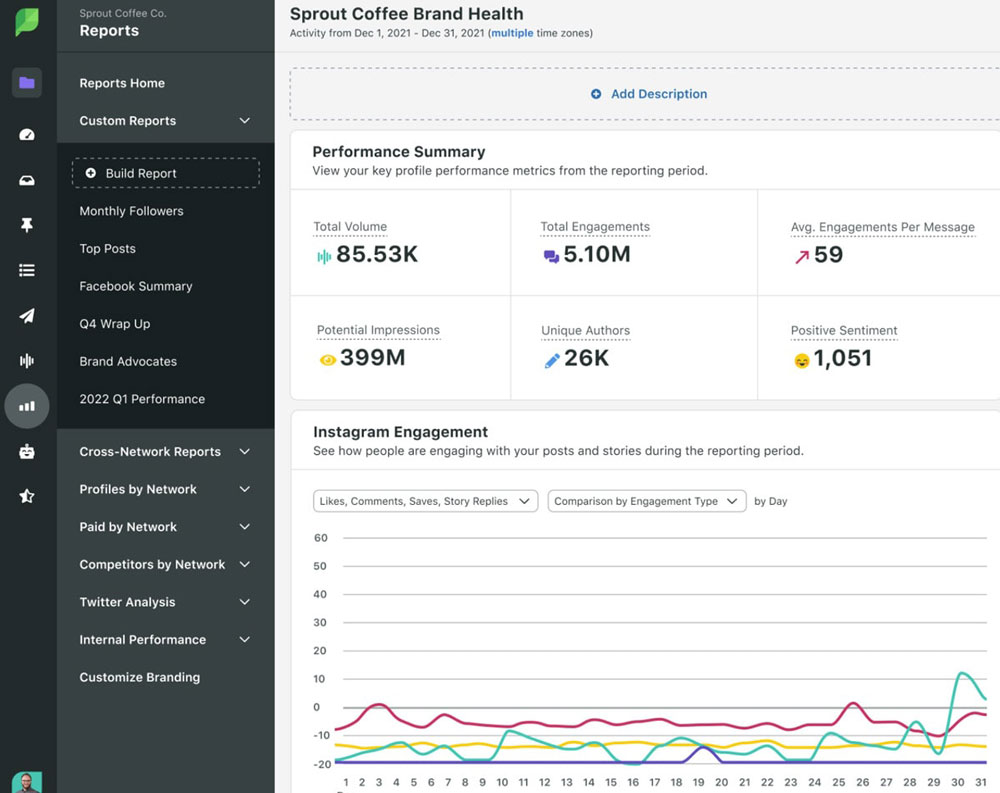
- Vista Social: All-in-one social media management platform offering features like scheduling, analytics, listening, review management, and more.
- Flick AI: Offers advanced Instagram profile analytics and hashtag performance analytics along with AI-powered content creation and scheduling features.
- Google Analytics: Tracks website traffic originating from social media, helping you measure ROI.
4. Evaluate Your Social Media Content Strategy
Your content must support your business objectives for your social media strategies to be effective.
Users actively engaging with your posts by liking, commenting, and sharing indicate that you are reaching your target audience with your content. Compare engagement rates across different post types and platforms.
You also need to evaluate content formats that resonate best with your audience. For instance, you may find more engagement with videos and less with just text.
Make sure your content stays true to your brand voice and identity across all social channels.
Follow these tips to evaluate your content strategy for different social channels:
- Compare engagement rates across different formats like videos, images, and text to see what resonates best. Experiment with different social media images and video post ideas.
- Look beyond likes and monitor interactions like comments, shares, and replies and identify your top-performing posts.
- Use tools like Vista Social, Semrush’s AI Social Media Post Generator, and Tailwind for content planning, post ideas and prompts, and AI-generated social media captions.
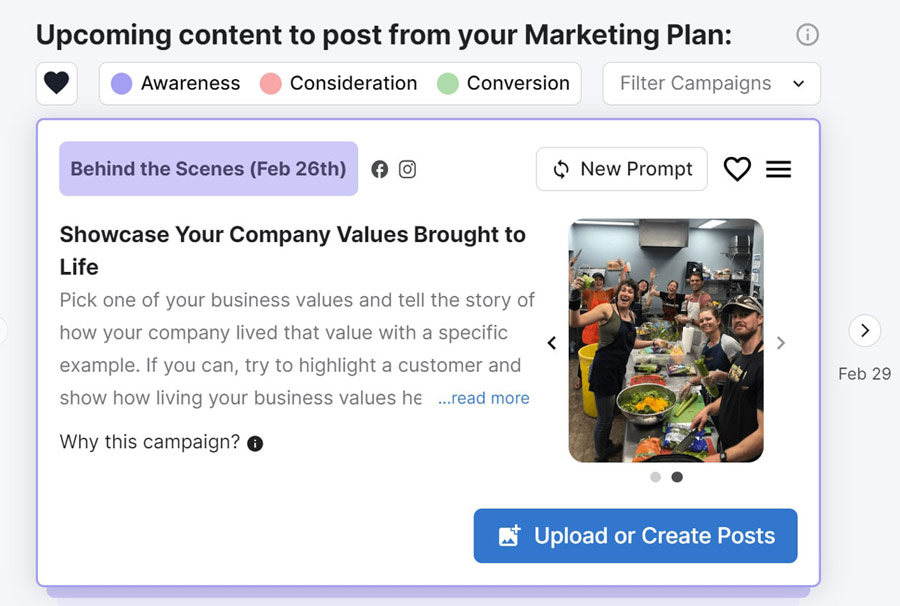
- Experiment with different posting schedules and analyze trends in engagement. You can use Post Planner to create a content calendar, schedule posts, and directly publish them to your profiles.
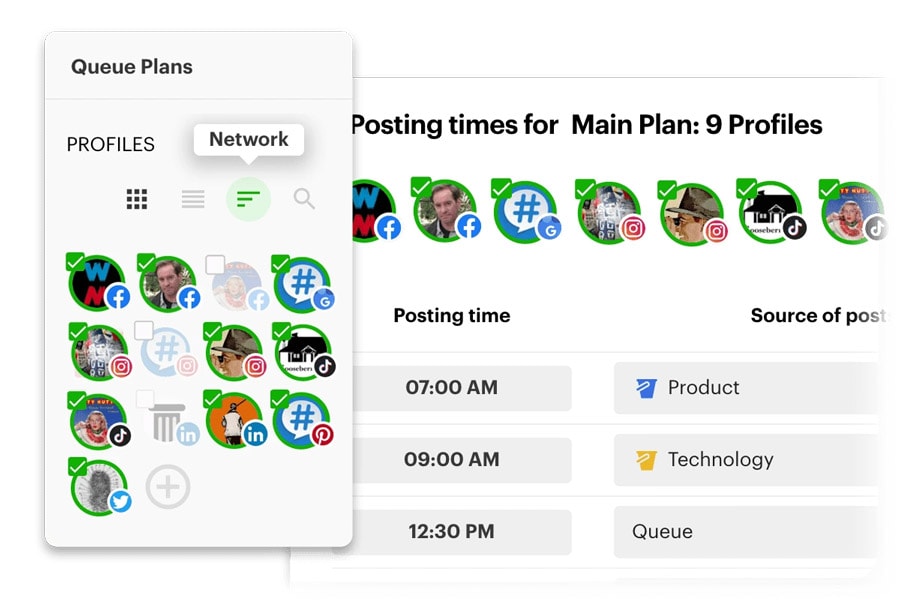
- Encourage audience interaction through polls, questions, and direct messages to understand their preferences.
- Make informed decisions about your content strategy based on concrete evidence and analysis.
5. Understand What’s Working for Your Social Media Audience
Building a successful social media presence depends on how well you know your audience. You must understand their demographics, interests, and behaviors to tailor your content and build strong connections.
As mentioned, you can explore audience demographics using analytical tools. Track their interests based on age, gender, location, and language.
Conduct polls and surveys on your platforms to gather specific feedback and preferences. You can also host Q&A sessions or encourage comments and direct messages to get their opinions and suggestions.
Here is how to align your content strategy with your audience:
- Create content directly addressing your audience's interests, needs, and pain points. Use relevant language, humor, and visuals that resonate with their cultural context.
- Post when your audience is most active and adjust your frequency based on their preferred content consumption habits.
- Encourage comments, questions, and discussions by actively engaging in conversations. Respond to feedback promptly and show genuine interest in building relationships.
- Go beyond promotional messages and provide genuine value with content that informs, educates, entertains, and inspires. For example, I experimented with SEO-related memes on my Instagram profile and the engagement metrics were too good to ignore.
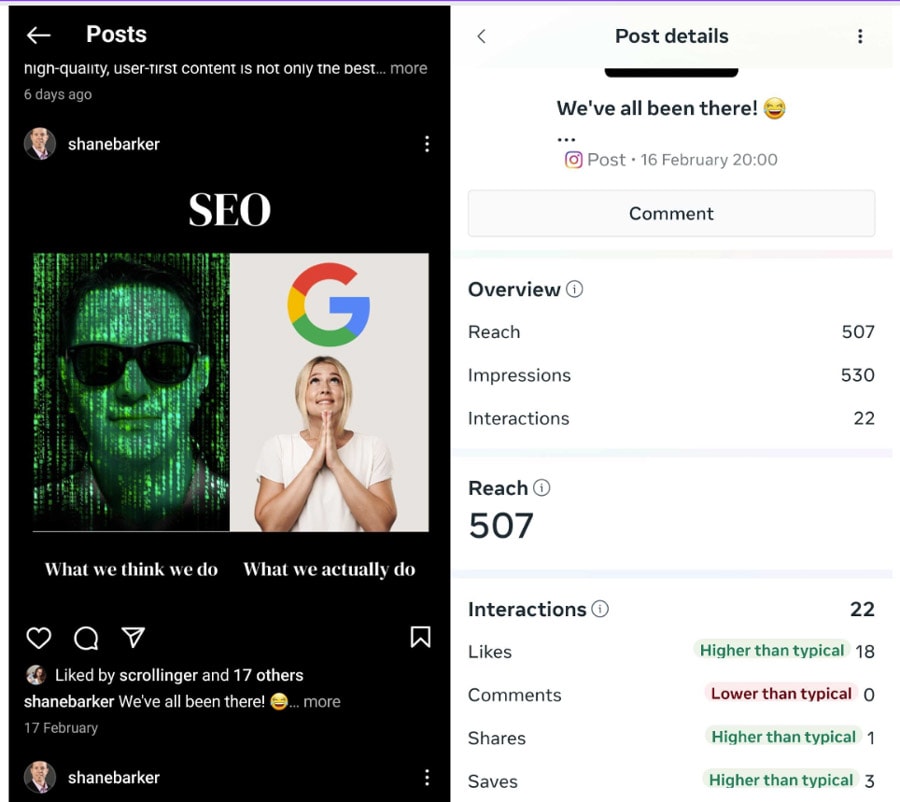
- Constantly test different approaches, analyze results, and adapt your strategy based on audience feedback.
6. Run a Competitive Analysis
Knowing your competitors' strengths and weaknesses on social media is necessary for optimizing your own strategy.
Here are the steps to perform a competitive analysis:
- Identify your competitors who are active on social media. For instance, you may consider brands that are also after your target audience and offering similar products or services.
- Focus on platforms where both you and your competitors are most active.
- Analyze content types, posting frequency, engagement rates, audience demographics, and brand sentiment.
- Compare your metrics to your competitors' performance to identify strengths and weaknesses.
- Analyze their top-performing posts and engagement strategies. Look for gaps in their approach that you can capitalize on.
- Identify areas where your competitors outperform you and the potential risks they pose.
With these insights, you can adapt your content based on what resonates with your audience and what your competitors lack. Address topics or themes neglected by your competitors to cater to specific audience needs.
Stay ahead by spotting emerging trends your competitors haven't embraced yet. Highlight your unique brand voice and strengths to stand out from the crowd.
Remember: Don't copy your competitors; find inspiration and adapt it to your unique brand identity.
7. Implement Changes in Your Social Media Strategy and Monitor Performance
After performing a comprehensive social media audit, you need to translate insights into action and monitor progress to ensure sustained success.
Share the audit findings and action plan with your teams to execute the plan effectively. For example, marketing, communications, and customer service.
Don't try to change everything at once. Instead, identify high-impact areas based on your audit findings and business goals and start with them to build momentum and demonstrate the value of the audit.
Assign specific tasks and deadlines for each change you want to implement, and be prepared to adapt your approach based on performance data and audience feedback.
Here are some tips for ongoing social media audits:
- Schedule regular audits quarterly or annually to track progress and identify new opportunities.
- Stay ahead of social media trends and platform updates to ensure your strategy remains relevant.
- Regularly review your social media goals and ensure your strategy and content are still aligned with them.
- Use powerful social media monitoring and social listening tools to track results.
- Adapt your approach as your business objectives or target audience change.
It’s Your Turn to Perform a Social Media Audit!
Performing a social media audit regularly is essential to optimize your online presence and achieve your marketing goals.
Use these insights to optimize your social media profiles, tailor content to your audience, and track progress toward your goals. By implementing your audit findings, you can refine your strategy, cultivate stronger connections, and watch your online presence flourish.


Related Articles
The Right Time to Post on Social Media: A Reliable Guide
7 Best B2C Marketing Channels for Social Media in 2024
How to Grow Social Media Organically: 19 Tools You Need To Use in 2024
30 Best Social Media Marketing Tools in 2024
7 Social Media Analytics Best Practices You Should Follow
19 Best Social Media Management Tools for Marketers in 2024